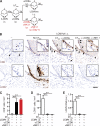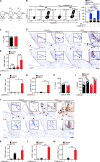Brain-resident memory T cells represent an autonomous cytotoxic barrier to viral infection
- PMID: 27377586
- PMCID: PMC4986533
- DOI: 10.1084/jem.20151916
Brain-resident memory T cells represent an autonomous cytotoxic barrier to viral infection
Abstract
Tissue-resident memory T cells (TRM) persist at sites of prior infection and have been shown to enhance pathogen clearance by recruiting circulating immune cells and providing bystander activation. Here, we characterize the functioning of brain-resident memory T cells (bTRM) in an animal model of viral infection. bTRM were subject to spontaneous homeostatic proliferation and were largely refractory to systemic immune cell depletion. After viral reinfection in mice, bTRM rapidly acquired cytotoxic effector function and prevented fatal brain infection, even in the absence of circulating CD8(+) memory T cells. Presentation of cognate antigen on MHC-I was essential for bTRM-mediated protective immunity, which involved perforin- and IFN-γ-dependent effector mechanisms. These findings identify bTRM as an organ-autonomous defense system serving as a paradigm for TRM functioning as a self-sufficient first line of adaptive immunity.
© 2016 Steinbach et al.
Figures









References
-
- Ariotti S., Beltman J.B., Chodaczek G., Hoekstra M.E., van Beek A.E., Gomez-Eerland R., Ritsma L., van Rheenen J., Marée A.F., Zal T., et al. . 2012. Tissue-resident memory CD8+ T cells continuously patrol skin epithelia to quickly recognize local antigen. Proc. Natl. Acad. Sci. USA. 109:19739–19744. 10.1073/pnas.1208927109 - DOI - PMC - PubMed
Publication types
MeSH terms
Substances
LinkOut - more resources
Full Text Sources
Other Literature Sources
Molecular Biology Databases
Research Materials

